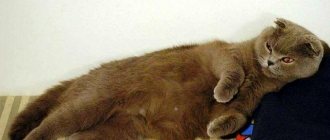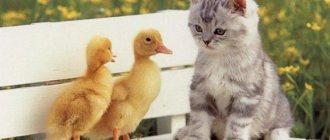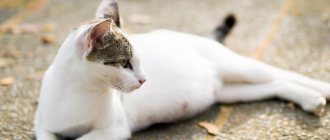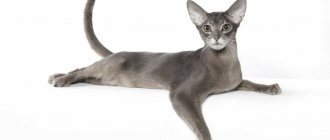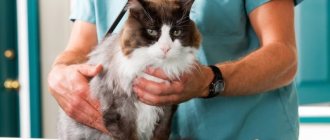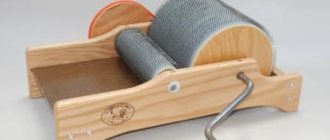General signs of illness
Not all diseases of British cats can be detected at an early stage. But if you carefully observe your pet, you will notice that he is not feeling well.
Signs of illness:
- lethargy, drowsiness;
- refusal to eat or loss of appetite;
- deterioration in the condition of the coat - it looks unkempt and loses its healthy shine;
- stool disorders - diarrhea or constipation;
- vomit;
- discharge from the nose, eyes;
- unsteadiness of gait or lameness;
- the cat walks with its mouth open and tongue hanging out;
- difficulty or rapid breathing;
- wheezing.
If at least one of the listed symptoms is detected, you need to examine the Briton and measure his temperature. If the thermometer is above 39 degrees or below 37.5, the cat needs to be taken to the vet immediately.
Symptoms of joint damage
The first thing you will notice when a cat develops arthritis or arthrosis is behavioral changes. If before the pet loved to run, jump and play, now he takes care of his paw and avoids stress. At stages II and III of the disease, the animal experiences pain even when moving short distances (for example, from one room to another).
The main symptoms of arthritis and arthrosis in cats:
- Soreness . It is observed in the affected area, while the pet becomes angry if someone tries to touch it, and meows loudly;
- Stiffness . The animal loses motor activity and rests more often. Begins to walk slowly and limp;
- Edema . There is swelling in the problem area. The cat's body temperature rises, especially with severe pain;
- Crunch . Due to the destruction of the layer between the cartilages, strong friction of the bones occurs, so when the cat moves, a specific crunching sound (rough, dry clicking) may be observed.
Note! Arthritis and arthrosis negatively affect the appearance of the pet. Because of the pain, he practically stops caring for his fur: it becomes dirty and gets tangled.
Pedigree diseases of British cats
Although British cats are in good health, some diseases are still common in this breed. Its representatives often suffer from heart problems, as well as blood clotting disorders.
British people are prone to obesity, so it is important to monitor their diet. Another common pathology in this breed is disappearing kitten syndrome.
Hypertrophic cardiomyopathy
This disease quite often develops in British cats and representatives of some other breeds - Ragdolls, Persians, Scottish Folds, and American Shorthairs.
It is characterized by thickening of the walls of the left ventricle and a decrease in the efficiency of the heart. The disease is often asymptomatic or manifests itself with difficulty or rapid breathing, as well as signs of lethargy.
British cats with hypertrophic cardiomyopathy often experience shortness of breath in stressful situations. For example, during transportation or during a veterinary examination. This disease cannot be cured completely. But you can keep your pet alive with inhibitors, calcium channel blockers and diuretics.
Hypertrophic cardiomyopathy in cats may not appear outwardly in the absence of physical activity. To avoid possible complications, Britons are advised to have a cardiac echocardiogram before undergoing a planned operation, such as castration.
Expert opinion
Chepa Natalya Semenovna
Veterinarian
Ask a Question
Among cats, fold-eared breeds are most prone to otitis, because... they have a small closed ear and a narrow ear canal that is poorly ventilated. Hairless breeds produce a lot of sulfur, which can also be a predisposing factor for the development of otitis media. A common mistake owners make when caring for their ears is using a cotton swab. It will not be possible to clean the ear well with a cotton swab due to its structure, but leaving the cotton swab, “compacting” the wax inside the passage and causing irritation of the skin of the ear canal is quite likely. For home care, it is best to use special lotions no more than once a month. You should not use multi-component ear drops on your own. Medications should be prescribed by a doctor based on a cytological examination.
Hemophilia
This disease is characterized by a blood clotting disorder. British cats are prone to bleeding. Even a small wound on the body can cause death due to blood loss. Also, due to hemophilia, internal bleeding often occurs and blood clots form in the vessels.
Signs of the disease may go undetected for a long time. The owner of a British cat should be alert and pay attention to the following warning signs:
- the appearance of hematomas;
- bleeding gums;
- black feces (indicates bleeding in the digestive organs);
- the appearance of blood in the urine;
- persistent bleeding after surgery.
Hemophilia is an incurable disease. Blood plasma transfusions are used to stabilize the cat's condition.
Disappearing kitten syndrome
This is not a disease, but a pathology associated with incompatibility of blood groups. The breed of British cats is characterized by 2 types of blood - A and B, while in other breed lines type B is almost never found. The problem occurs when a cat with type B blood mates with a cat who has type A or AB blood. Then future kittens will inherit type A or AB.
Already during pregnancy, the cat produces antibodies against type A blood, but they do not penetrate the placenta to the fetus. While the kittens are in the womb, they are not in danger.
As soon as the babies are born and begin to suck milk, they will die within 1–2 days. This happens because antibodies in mother's milk enter the bloodstream through the intestinal wall and destroy the kittens' red blood cells.
As a result, they quickly die from anemia. In rare cases, a kitten manages to survive, but then the tip of its tail dies off.
To avoid the death of British newborns, it is advisable for breeders to select a partner for a cat with the same blood type. Special tests are used for this.
If kittens have already been born whose blood is incompatible with their mother’s, then it is recommended to find them a temporary nurse. Within 3–4 days, the intestinal walls of the babies will become impenetrable to the mother’s antibodies, and the kittens will be able to feed on her milk.
Tendency to obesity
Another common disease in British breed cats is obesity. The main reason for rapid weight gain is hormonal imbalance and disruption of the endocrine system. However, not all animals have these problems. Obesity often develops due to overfeeding a pet.
British cats have a good appetite. They love to sit with a sad look near the bowl and beg for the next portion of food. The problem is aggravated by the cat's low mobility. Due to lack of time, owners rarely play with their pets, so they sleep most of the day. British cats over 3 years of age and all pets who have undergone castration are at risk for obesity.
This disease has very serious consequences. Excess weight increases the load on the heart and pancreas. The blood vessels become less elastic, and the balance of hormones is disrupted. Obesity in a British cat sometimes leads to the development of diabetes.
Fortunately, this problem can be dealt with through diet and increased exercise.
What to do:
- choose low-calorie food;
- exclude treats from the diet;
- give food several times a day in small portions;
- play outdoor games with the cat more often;
- take your pet for a walk.
Hip dysplasia
This disease affects approximately 5% of British cats. It is characterized by a disruption of the normal functioning of the joints, a decrease in their mobility and a change in shape. It is still unknown what exactly provokes the development of dysplasia. There are suggestions that predisposition to the disease is inherited.
At an early stage, pathology is difficult to detect. As the disease progresses, the British cat experiences a decrease in physical activity, unsteady gait, and lameness. It is difficult for the animal to get up due to pain in the joints.
Treatment of the disease involves following a diet, using anti-inflammatory drugs and analgesics. Veterinarians also prescribe medications to restore cartilage tissue. In advanced cases, surgery to resection the femoral head is recommended.
Life forecasts
Osteochodrodysplasia of Scottish cats cannot be considered a factor reducing life expectancy. With proper care, a Scottish cat suffering from this disease can live a long and happy life.
Therefore, you should not agree to euthanize your pet, recommended by unscrupulous and illiterate veterinarians. Give your furry friend a chance to live comfortably next to you.
Euthanasia is indicated in those rare cases when painkillers do not have an effect on the sick animal, and the cat suffers from constant pain. In this case, a quiet departure from life, reminiscent of falling asleep, will be a merciful decision.
Osteochondrodystrophy is not a death sentence for a pet, but due to its genetic nature, this disease cannot be fully treated.
Prevention of pathology is a careful study of the animal's pedigree: breeding two Scottish fold cats is prohibited. If the disease has already been diagnosed, it is necessary to create comfortable living conditions for the pet.
British cats are considered one of the healthiest breeds among the cat family, but they are also susceptible to illnesses. In good living conditions, they live for at least 15 years. There are even centenarians who live 30 years.
The owner of the pet should be aware of the peculiarities of their health. The most important thing is to recognize the disease in the early stages. Let's look at what diseases can affect a cat during its life.
Diseases of British cats require the attention of a veterinarian.
Eye diseases
Due to shortened nasolacrimal ducts, British cats often develop ophthalmic diseases. In addition, representatives of this breed often have watery eyes, and unsightly dark brown crusts form in the corners.
With insufficient care, the British develop conjunctivitis - inflammation of the mucous membrane of the eyeball.
The disease can be caused by:
- viruses;
- pathogenic bacteria;
- allergies.
Attention! The appearance of purulent discharge from the eyes of a British cat cannot be ignored. If left untreated, inflammation can affect the cornea, which can lead to partial or complete loss of vision.
Tearing, swelling and redness of the eyelids with pus discharge may be a symptom of an infectious disease. In this case, other signs of the disease are added - lethargy, loss of appetite, fever, difficulty breathing, runny nose.
Treatment for conjunctivitis varies depending on the cause, so it is advisable to take your British cat to the veterinarian. He will prescribe antiviral, antibacterial eye drops or antihistamines, as well as immunostimulants.
Discharge from the eyes will have to be removed before each use of medications. Treatment of conjunctivitis lasts 5–7 days.
What other pathologies can the British have?
British cats sometimes suffer from diseases that are caused by metabolic disorders, such as diabetes. They are also not immune to problems with the digestive tract, infectious and parasitic diseases.
Diabetes
This disease occurs in adult and older British cats. Its development is promoted by metabolic disorders. Most often, diabetes occurs in pets with obesity or diseases of the gastrointestinal tract - ulcers, gastritis. Sometimes the problem occurs due to hormonal imbalances.
Diabetes mellitus is characterized by insufficient production of the pancreatic hormone, insulin, which is responsible for blood sugar levels. Timely diagnosis of this pathology is difficult.
Typically, when symptoms of diabetes appear, the British cat has already developed a strong dependence on insulin. However, the attentive owner should be alert to the following alarming symptoms:
- strong thirst;
- unkempt fur;
- changes in appetite - either it disappears or increases;
- weight loss;
- frequent urge to urinate and increased amount of urine produced.
When the disease is already advanced, the British cat develops an acetone odor from the mouth, muscle tone weakens, and the mucous membranes acquire a yellowish tint. Also, convulsions often occur, the pet loses consciousness, and vomiting occurs.
Treatment for diabetes involves putting your cat on a low-carbohydrate diet and taking medications to lower blood sugar levels. Insulin injections are recommended for some pets.
Gastritis
Inflammation of the gastric mucosa in a British cat can develop at any age and for various reasons:
- due to poor nutrition;
- allergies;
- while taking medications;
- due to helminthic infestations;
- stress.
Acute gastritis is characterized by pain in the epigastric region, refusal to eat, frequent regurgitation, diarrhea and fever. When the disease is chronic, the cat periodically feels sick and vomits. During periods of exacerbation, the Briton becomes lethargic, lies down, does not want to play, and does not allow his stomach to be touched. However, after some time the pet’s well-being improves.
Treatment for this disease is prescribed by a veterinarian. Usually his tactics are determined according to the level of acidity and the condition of the British cat. The doctor will prescribe antispasmodics, medications that coat the walls of the stomach, as well as anti-inflammatory and antiemetic drugs.
Diet plays an important role in the treatment of gastritis.
Parasitic diseases
British cats, like representatives of other breeds, are not protected from ticks, fleas and helminths. A cat can become infected with parasites even if it does not go outside.
Otodectosis
The causative agent of this disease is the mite Otodectes cynotis, which parasitizes the external auditory canal. It causes severe itching in the ears. An infected cat becomes restless, constantly shakes its head, scratches the sore shell and meows pitifully.
Mechanical damage to the ear tissue often leads to the addition of a bacterial infection, and then the pet develops otitis media. This is very dangerous - if left untreated, inflammation can spread to the eardrum, and then to the lining of the brain.
To treat this disease, acaricidal ear drops with an anti-inflammatory effect are used.
Demodicosis
This parasitic disease is caused by Demodex mites. They affect the skin and hair of cats. Symptoms of demodicosis in British cats:
- redness and peeling of the skin;
- hair loss;
- the appearance of bleeding wounds and nodules in different parts of the body;
- itching, anxiety;
- lethargy;
- loss of appetite.
With demodicosis, areas of the body are usually affected in the head, neck, sides of the torso, as well as limbs. Treatment for this disease is long - about 2 months. To destroy subcutaneous mites, a 2–4% solution of lime sulfur is used, which is used to treat the body every 5–7 days.
Once a week, subcutaneous injections of Doramectin are given at a rate of 0.2–0.6 mg/kg of British cat weight.
Helminthiasis
Roundworms and tapeworms develop in the intestines and other digestive organs. They have a negative impact primarily on the immune system. Symptoms of worm infection:
- diarrhea alternating with constipation;
- poor appetite;
- lethargy;
- deterioration of coat condition, loss of shine;
- vomit;
- cough (occurs with ascariasis).
Drontal, Pyrantel, and Stronghold are used to treat helminthiases in British cats. The cat is wormed twice with an interval of 10–14 days. One dose will kill the worms and the second will kill the larvae that will hatch from the eggs within 2 weeks.
Fungal diseases
British cats often become infected with fungal diseases. Some of them are dangerous for humans, for example, ringworm. A fungal infection affects your pet's skin, fur, and nails.
Lichen
The greatest danger is ringworm. The disease is caused by 2 types of fungi - Microsporum and Trichophyton. The main symptom of infection is the appearance of areas of skin without hair on the body. Ringworm is predominantly round or oval in shape with clear boundaries. When examining the lesion, broken hairs are clearly visible. It looks like the fur was trimmed with scissors.
Treatment of this disease requires an integrated approach. In addition to the use of antifungal ointments, the veterinarian may prescribe oral tablets, diet, and medications to strengthen the immune system.
Claw fungus
British cats are often diagnosed with nail fungus. The owner of the animal should periodically inspect the paws. If the claws become deformed, become very peeling, or dark spots appear on them, you should consult a veterinarian. Perhaps this is a fungal infection of the horny tissue. If the diagnosis is confirmed, the veterinarian will prescribe ointments to treat the claws.
Infectious diseases
Infectious diseases of a viral nature are considered the most dangerous. British cats that do not come into contact with sick animals outside can also sometimes become infected. The owner can bring the infection on his clothes or shoes, but this rarely happens. Another way of transmitting the disease is through fleas and ticks.
Panleukopenia
People call this disease plague. It is caused by a DNA virus from the parvovirus group. It affects the animal's lymphatic system, small intestine and bone marrow.
Symptoms:
- temperature rise to 41 degrees;
- vomit;
- diarrhea;
- refusal to eat;
- oppression;
- conjunctivitis;
- dry skin and mucous membranes;
- dulling of wool.
Panleukopenia is especially dangerous for kittens. Mortality in animals under 10 months of age reaches 90%. Adults recover if therapy is started on time. After an illness, a cat remains a carrier of the virus forever.
To treat plague, the drugs Tylosin 50 and Fosprenil, as well as immunostimulants, are used. Annual vaccination will help protect your British cat from infection.
Calcivirosis
Another deadly disease is calcivirosis. It is caused by the Feline calicivirus, which affects the respiratory system, joints, gastrointestinal tract and eyes. Symptoms of the disease appear suddenly:
- the temperature rises to 40–41 degrees;
- ulcers appear in the mouth;
- conjunctivitis develops;
- mucous discharge flows from the nose;
- Some cats develop lameness.
British cats under one year of age who become infected with calcivirus often die from pneumonia. Antiviral, immunostimulating drugs and antibiotics are used to treat the disease. Vaccination against calcivirus is included in the list of mandatory ones; it is given to cats every year.
Causes of arthritis and arthrosis
The development of arthrosis is most often caused by a violation of vitamin and mineral metabolism, incorrect positioning of the limbs, as well as anomalies affecting the articular surfaces. Arthritis often occurs when the immune system is dysfunctional (for example, when a pet is exposed to the cold for a long time).
Other common causes of arthritis and arthrosis in cats:
- Injuries
Various injuries (for example, an unsuccessful landing from a height, a fall, torn ligaments) can cause the development of arthritis or arthrosis, since ligaments are injured along with bones and internal organs.
- Metabolic disorders
Improper metabolism of substances, vitamins and minerals in the pet’s body leads to weakening of the joint tissue. It is not renewed due to an insufficient amount of “building materials” in the body.
- Age-related changes
Osteoarthritis is often diagnosed in older cats, since the joints quickly wear out and practically do not recover. Owners whose pets suffer from obesity need to be especially careful.
- Overweight
Most often, obesity is provoked by poor nutrition and lack of physical activity (usually in domestic cats). Excessive weight puts a lot of stress on the joints, which are not always able to withstand it.
- Genetic predisposition
Some diseases of the musculoskeletal system are transmitted genetically (for example, dysplasia of the elbow or hip joint). It is recommended to begin veterinary observation of such pets at a young age.
- Infectious diseases
A number of infections affect the joint tissues of the body, slowing down their subsequent renewal and causing inflammatory processes. Thus, the disease can develop against the background of viral hepatitis, chlamydia or bronchitis.
Disease Prevention
It is much easier to prevent health problems in an animal than to treat them. The owner of a British cat must provide her with good care and adequate nutrition.
You should not overfeed your pet or give it food from the human table. Veterinarians recommend using only premium food and higher. It is also important to ensure that the cat moves more.
Particular attention must be paid to hygiene. It includes care for:
- oral cavity;
- eyes;
- ears;
- wool.
To prevent helminth infection, cats are dewormed 2 times a year. When kittens are 12 weeks old, they are vaccinated against infectious diseases - chlamydia, rabies, calcivirosis and panleukopenia. Then vaccination is carried out annually.
Many diseases that affect British cats can be avoided if you treat your pet carefully, examine it and regularly take it to a veterinarian for consultation. Monitoring the health of a cat is the direct responsibility of its owner.
General diseases
British shorthairs also suffer from diseases that occur in both their relatives of the Scottish breed and ordinary cats.
- Respiratory diseases.
- Worms.
- Diseases of the eyes and teeth.
- Claw diseases.
These types of illnesses are the least dangerous and can be easily avoided by providing your Brit with proper care.
To avoid problems with the eyes, wash them daily with chamomile infusion or ordinary boiled water.
The oral cavity must be kept clean, and the change in smell and condition of the cat’s teeth must be monitored.
